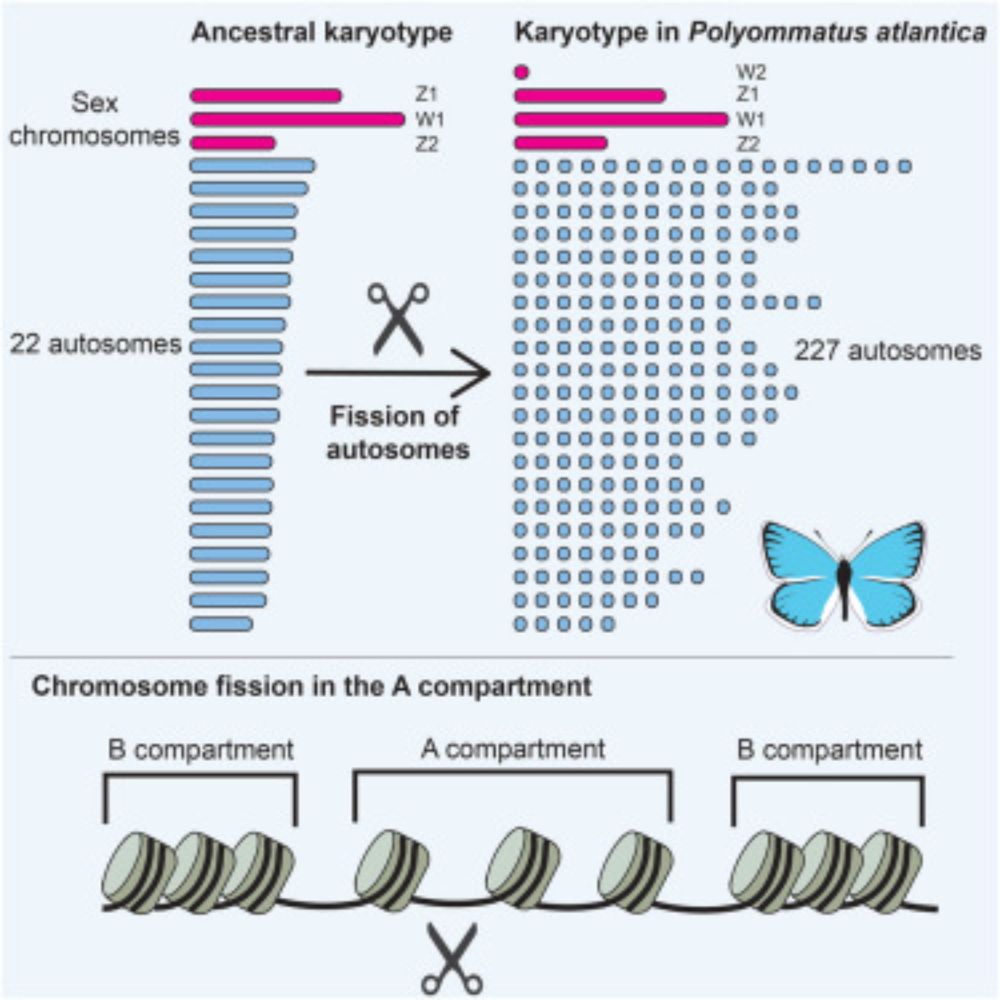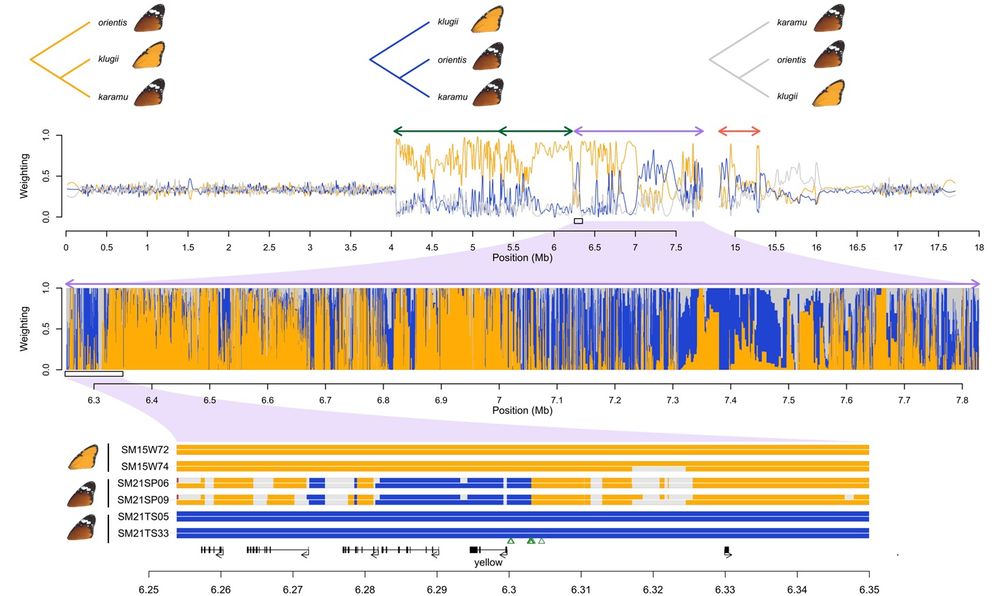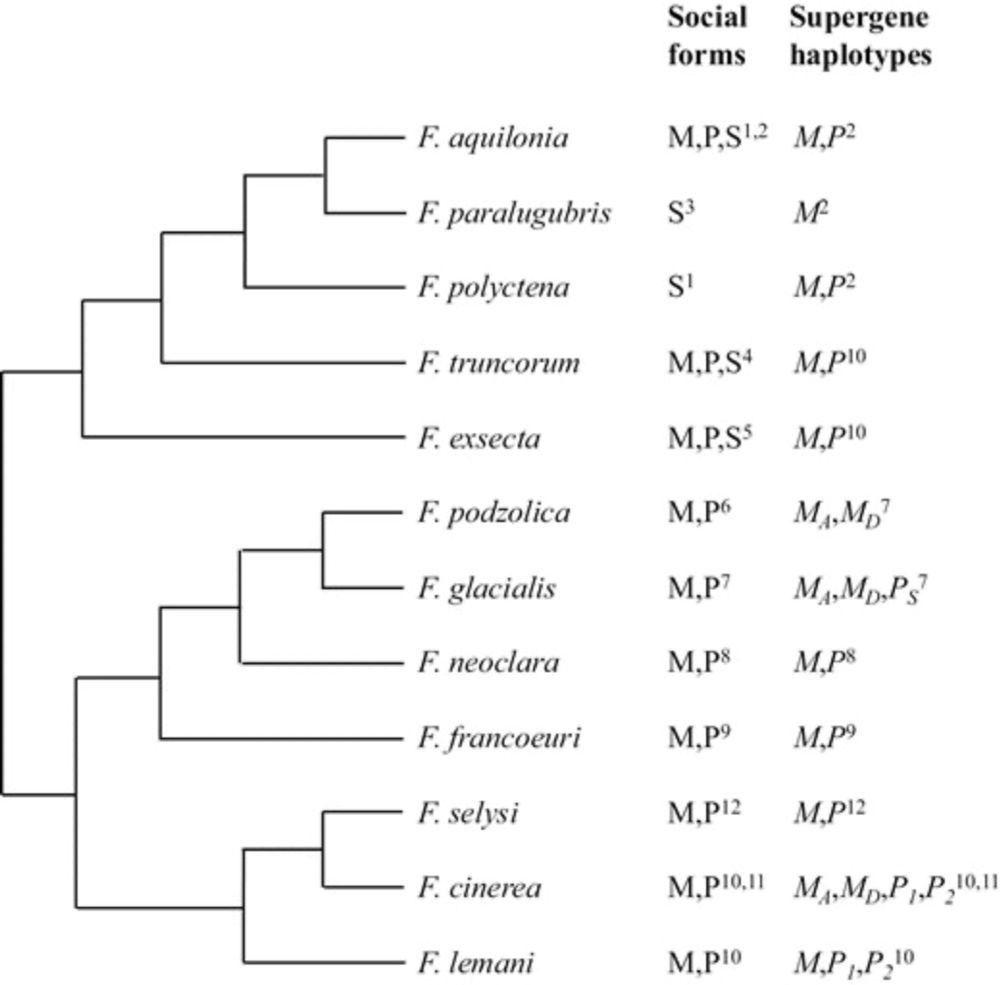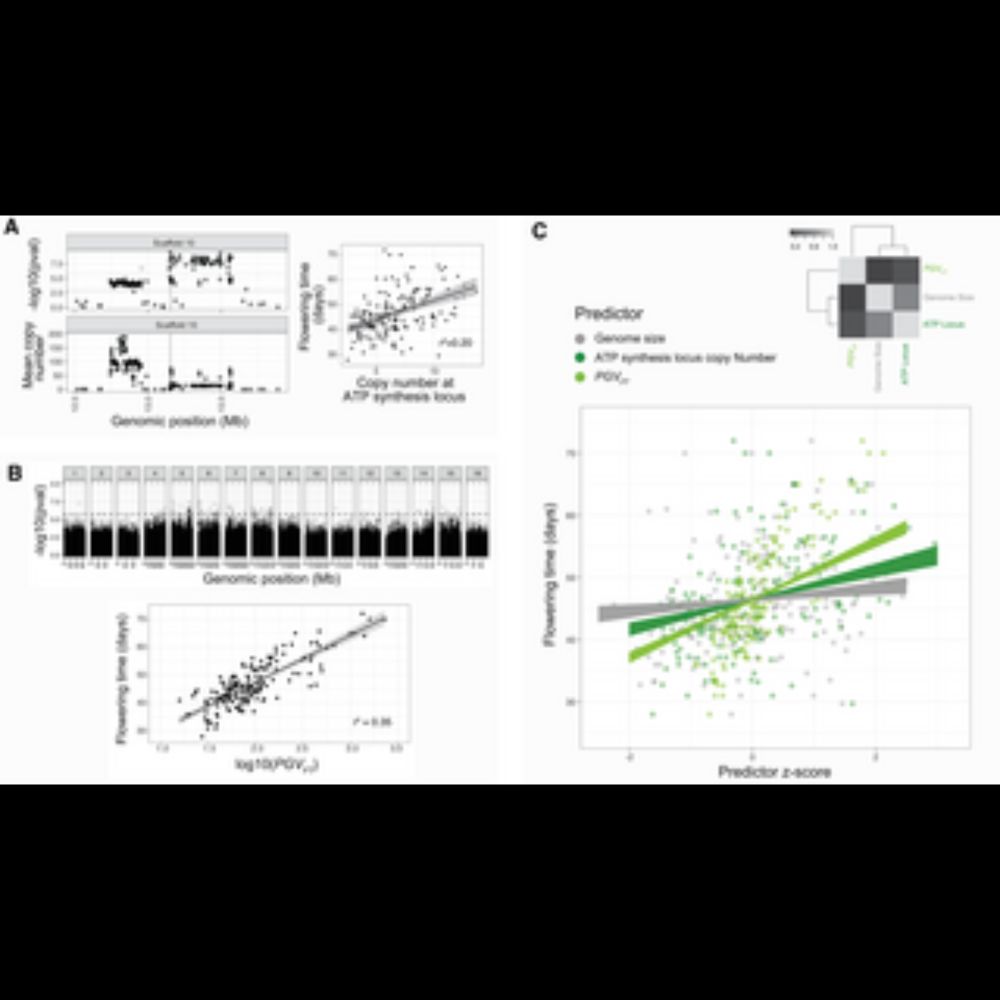
Constraints on chromosome evolution revealed by the 229 chromosome pairs of the Atlas blue butterfly
The genome of the Atlas blue butterfly contains ten times more chromosomes than most
butterflies, and more than any other known diploid animal. Wright et al. show that
this extraordinary karyotype is ...
How many chromosomes can an animal have?
In our paper out now in @currentbiology.bsky.social we show that the Atlas blue butterfly has 229 chromosome pairs- the highest in diploid Metazoa! These arose by rapid autosome fragmentation while sex chromosomes stayed intact.
www.cell.com/current-biol...
11.09.2025 15:21 — 👍 209 🔁 99 💬 4 📌 6
ggplot2 ethusiasts, new update just dropped! 🔥🔥🔥
11.09.2025 13:33 — 👍 1 🔁 0 💬 0 📌 0

ggplot2 4.0.0
A new major version of ggplot2 has been released on CRAN. Find out what is new here.
I am beyond excited to announce that ggplot2 4.0.0 has just landed on CRAN.
It's not every day we have a new major #ggplot2 release but it is a fitting 18 year birthday present for the package.
Get an overview of the release in this blog post and be on the lookout for more in-depth posts #rstats
11.09.2025 11:20 — 👍 847 🔁 282 💬 9 📌 51
Check out our latest preprint in Formica ants! We investigate how the sex ratio supergene evolved. We find that a colony-level sex ratio supergene evolved twice! This likely occurred as a result of recombination between the the ancestral queen number supergenes present in Formica. 🧬🐜🧬🐜🧬🐜
02.09.2025 14:32 — 👍 3 🔁 0 💬 0 📌 0
Led by Jessica Purcell. The team included @giuliascarparo.bsky.social , Madison Sankovitz, Mari West, Zul Alam, and Alan Brelsford.
24.07.2025 14:10 — 👍 1 🔁 1 💬 0 📌 0
There were ~10% of colonies showing mismatches between supergene genotype and phenotype, but we only observed this at one site. This raised the possibility that environment may override supergene control of colony queen number.
24.07.2025 13:39 — 👍 1 🔁 0 💬 1 📌 0
Colonies with single queens were more common in the north, but the queen number polymorphism was present throughout the gradient. The supergene haplotype frequency reflected this as the frequency also varied with latitude.
24.07.2025 13:39 — 👍 0 🔁 0 💬 1 📌 0
We sampled Formica podzolica colonies across a latitudinal gradient between Alaska and New Mexico. Surprisingly, Formica podzolica has SIX(!) common supergene variants that are differentiated by three distinct cassettes.
24.07.2025 13:39 — 👍 0 🔁 0 💬 1 📌 0
Very pleased to see this officially out - Genome Architecture and Speciation in Plants and Animals. With @siluwang.bsky.social, @dortizba.bsky.social and Loren Rieseberg. onlinelibrary.wiley.com/doi/10.1111/...
27.06.2025 13:22 — 👍 47 🔁 30 💬 0 📌 0
Thanks to Zul Alam and Alan Brelsford for their work on this! (4/n)
09.04.2025 14:02 — 👍 0 🔁 0 💬 0 📌 0
Taken together, these results suggest that supercoloniality isn't as simple as having the multi-queen supergene haplotype. (3/n)
09.04.2025 14:02 — 👍 0 🔁 0 💬 1 📌 0
We find that the multi-queen haplotype is missing from a supercolonial population. Additionally, we find a similar pattern with the multi-queen haplotype being absent in one supercolonial species, but present in another. (2/n)
09.04.2025 14:01 — 👍 1 🔁 0 💬 1 📌 0
Is supercoloniality a simple extension of polygyny?Supercolonies, networks of interconnected nests with many queens, have been proposed as a natural extension of multi-queen nests. In many Formica ants, a supergene determines whether a colony has a single queen or many queens. (1/n)
09.04.2025 14:01 — 👍 2 🔁 2 💬 2 📌 0
Thanks to Zul Alam and Alan Brelsford for their work on this! (4/n)
09.04.2025 13:54 — 👍 0 🔁 0 💬 0 📌 0
Taken together, these results suggest that supercoloniality isn't as simple as having the multi-queen supergene haplotype. (3/n)
09.04.2025 13:51 — 👍 0 🔁 0 💬 1 📌 0
We find that the multi-queen haplotype is missing from a supercolonial population. Additionally, we find a similar pattern with the multi-queen haplotype being absent in one supercolonial species, but present in another. (2/n)
09.04.2025 13:51 — 👍 0 🔁 0 💬 1 📌 0
A novel supergene controls queen size and colony social organization in the ant Myrmica ruginodis https://www.biorxiv.org/content/10.1101/2025.03.24.644106v1
26.03.2025 16:31 — 👍 5 🔁 3 💬 0 📌 1

Top: Topology weightings across chr15 showing how the karamu haplotype is related to the klugii and orientis haplotypes. Upper panel shows three possible rooted genealogical topologies. Second panel shows weights for each topology along the chromosome, smoothed with a 20 kb span. Arrows above the plot indicate the locations of inversions. Third panel shows unsmoothed topology weightings across a 1.5 Mb region corresponding to Inversion 2. Bottom: Ancestry painting across a 100 kb region within Inversion 2, showing ancestry tracts for two homozygous karamu individuals compared to two representative individuals homozygous for the orientis and klugii haplotypes. Coding regions are indicated below the plot, with the candidate gene for background colouration yellow indicated. Green triangles represent the top 10 SNPs for background colour in our GWAS. There is evidence for recombination throughout the supergene region, and specifically in the vicinity of yellow, consistent with the hypothesis that orientis ancestry at this locus (i.e., the B allele) is associated with darker colouration in karamu individuals.
Dynamics of a supergene. A study of the BC supergene in wing color morphs of the African monarch #butterfly by @rishidekayne.bsky.social &co reveals dynamic evolution of #supergene haplotypes, fueled by incomplete recombination suppression 🧪 @plosbiology.org plos.io/3DiFhnL
03.03.2025 10:00 — 👍 53 🔁 31 💬 0 📌 2
Centromere evolution isn't a sudden switch!
Our study shows centromere transitions are a step-by-step process driven by a combination of drift and selection. Discover how the kinetochore interface shapes this gradual change in our new preprint 🥳 doi.org/10.1101/2025.01.16.633479 🧵(1/8)
17.01.2025 11:17 — 👍 101 🔁 40 💬 2 📌 4
🦉🧪 Questions about high latitude myrtle warblers have been "up in the air" (pun intended) since 1899! @stephszarmach.bsky.social used fancy new geolocators that track light AND barometric pressure to add an unexpected chapter to this tale ......
14.10.2024 13:10 — 👍 13 🔁 3 💬 0 📌 0
Thanks to Zul Alam and Alan Brelsford who contributed to this work! (and are not on Bluesky)
19.09.2024 21:34 — 👍 0 🔁 0 💬 0 📌 0
Our preprint on the unexpected absence of a multiple-queen supergene haplotype in supercolonial populations is up on bioRxiv! We found that the P haplotype is not necessary for supercoloniality in the Formica rufa group, despite its longstanding association with non-supercolonial polygyny.
19.09.2024 21:31 — 👍 2 🔁 0 💬 1 📌 0
Stacks
Happy to release Stacks v2.67 today. This release updates process_radtags to make it easier to use SRA data and to filter poly-G (error) runs coming from Nextseq/Novaseq machines + bugfixes. We also added a genotype depth filter to populations #RADseq
catchenlab.life.illinois.edu/stacks/
18.07.2024 17:50 — 👍 5 🔁 2 💬 0 📌 0

New article: 'The role of conflict in the formation and maintenance of variant sex chromosome systems in mammals'
🔬 From fusions to Y chromosome loss, sex chromosome karyotypes vary widely in mammalian genomes.
1/3
13.06.2024 16:01 — 👍 1 🔁 1 💬 1 📌 0
With a link that works 😊
21.03.2024 18:40 — 👍 10 🔁 5 💬 0 📌 1

Phylogenomics resolves key relationships in Rumex and uncovers a dynamic history of independently ev...
bioRxiv - the preprint server for biology, operated by Cold Spring Harbor Laboratory, a research and educational institution
Excited to share the first paper from my postdoc, using phylogenomics to uncover dynamic genome evolution in Rumex! Featuring @joannarifkin.bsky.social, @bmsacchi.bsky.social, @stepheniwright.bsky.social, and others not on the app!
www.biorxiv.org/content/10.1...
14.12.2023 22:40 — 👍 13 🔁 6 💬 0 📌 1
🐜🧬 Genomics & evolbio of red wood ants 🎓📚 SciComm and teaching of entomology, biodiversity genomics, & citizen science 🌍 By UniBo UniFi & UniPv, supported by @sib.swiss @biogeneurope.bsky.social @ergabiodiv.bsky.social
🔗 https://linktr.ee/antswoodwide
Research professor in ecology
@Université Libre de Bruxelles - @FNRS
Ant symbioses / Ecological networks / Myrmecophiles / Insects 🐜🌿🕷🦗🪲
www.thomasparmentier.com
Postdoc at UCR working on the evolution of Y-linked genes expression in Microtus voles.
Sex chromosomes, sexual polymorphism, sex determination, sex differentiation
International journal for the study of social arthropods 🐝🐜🪳
https://insectessociaux.com/
https://link.springer.com/journal/40
Professor of Population Genetics, Guam
Evolutionary Genomics, Marine Biodiversity, Corals, Molluscs, Sponges…
Mom and sponge researcher at @mncn-csic.bsky.social and scientific associate at @nhm-london.bsky.social. Interested in evolutionary biology of 🧽 . FLS. Views are my own.
Evolutionary Biologist of Squishy Marine Creatures. #Molluscs #corals
#Marine #Invertebrate #Genomics
@leibnizlib.bsky.social
Evolution, genomics, butterflies and moths 🦋
Postdoc in the Tree of Life, Wellcome Sanger Institute &
Research fellow at Darwin College, University of Cambridge
Evolutionary Biologist & Scientific Naturalist | Associate Professor | Director, E4 Initiative | @RiceUniversity #science #biology #evolution #speciation #entomology #biodiversity #genomics #discovery
Lab website: https://scottpegan.com
Based in New Zealand. Research: #seafood #genomics #adaptation. Editor-In-Chief for @EvolAppJournal. Prof at @AucklandUni. Science Group Leader @plantandfood
https://marenwellenreuther.com/
Scientist interested in Ants / Molecular Evolution / Population genomics / Phylogenomics
Assistant Professor in Ecology & Evolution at UChicago. Evolutionary genomics and behavior in fishes. (she/her)
https://rachelmoranlab.com
The Earth BioGenome Project (EBP), a moonshot for biology, aims to sequence, catalog, and characterize the genomes of all of Earth's eukaryotic biodiversity over a period of ten years.
🌲Keep up with all EBP updates: https://linktr.ee/earthbiogenomeproject
Assoc Prof of Biology. Indiana U. Interested in: mechanisms of behavior + how they evolve. she/her. https://rosvall.lab.indiana.edu/
Evolutionary social neuroscience postdoc in the CTRD program at Indiana University.
Rosvall and Hahn labs.
www.imillercrews.wordpress.com
Developing a European-level monitoring strategy for moundbuilding Formica ants and their myrmecophiles 🐜🐞🌍 | Part of @biodiversa.eu 🔬
www.monitant.de
Behavioral Ecology and Social Evolution Research Groups @unimainz.bsky.social
Official account of the Institute of Environmental Sciences, Faculty of Biology, Jagiellonian University, Krakow, Poland
Evolutionary Biologist at UCSC | Assistant professor | Interested in genes, genomes, and #evolution of complex traits 🧬 | EvoDevo Regeneration
https://macias.sites.ucsc.edu/
📸 IG: @cnidolab_ucsc
Evolutionary biologist. CNRS researcher at CEFE, Montpellier









